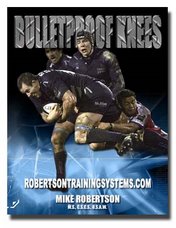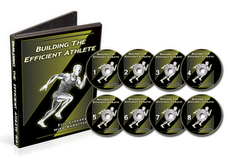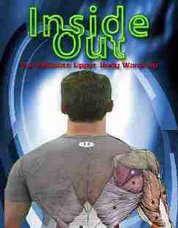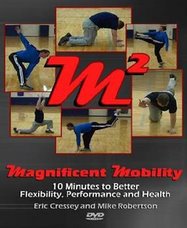...will be shown on my blog.
Chris Henry - you got JACKED UP!
High Octane Corrective Exercise and Performance Enhancement | www.RobertsonTrainingSystems.com
Friday, January 4, 2008
Thursday, January 3, 2008
Interview with Jim "Smitty" Smith of the Diesel Crew
Today, we're going to re-publish an interview I did with Jim "Smitty" Smith of the Diesel Crew last year. If you missed out, you need to sign-up for the newsletter ASAP!
___________________________________________________________________
Over the past year, I've had the pleasure of becoming friends with not just an amazing strength coach, but an amazing person as well. Jim "Smitty" Smith not only knows his stuff when it comes to the iron-work, but he's also one of the most genuine and good people I've met in a long time.
Smitty, gives us a little background on yourself.Mike, first off, thanks for the interview!
Well, many moons ago I was a scholastic wrestler and tennis player. But, it was during college where I started taking my training seriously. Like everyone else I followed the popular magazines and did tons of reps, sets and volume. The typical bodybuilding routine and this continued all through college. After I graduated, I wanted to continue to learn more about strength and how to develop athletes. In 2001, I become NSCA CSCS certified and that is when the journey began.
The Diesel Crew was founded shortly after by Jedd Johnson and myself.
Since then I have had the privilege to work with many great athletes, meet some of the most brilliant minds in the industry, create tons of articles, manuals and videos dedicated to the pursuit of strength through non-conventional protocols.
Who the hell is the Diesel Crew?
Much like you and Eric have been branded as the “Mobility guys”, Jedd Johnson and I have been dubbed the Grip guys – but this is only a small part of what we do.
The Diesel Crew was founded on developing strength utilizing old school training techniques. We did tons of research on Sandow, Arco, Inch, Cyr, Saxon and all of the other strongmen of old. Both of us coming from a bodybuilding background, we always were searching for something new. Something to refresh our strategies for our training programs.
We started with exercises like the bent press, 2 hands anyhow, the Steinborn lift, swings and zercher lifts and moved to powerlifting, weightlifting, kegs, sandbags, thick ropes, stones, kettlebells and then onto Grip.
The Grip tag has been hard earned. Over the last 4 years, we’ve studied Grip athletics in all its complexities. Our efforts led us to participating in many Grip competitions and putting on the largest Grip competition in the United States. It has been considered the US Grip Championships.
It is this in-depth study that has allowed us to provide others with the knowledge on how they too can incorporate Grip strength training into their programs.
Over the years, we hope that we’ve opened other trainers eyes to the fact that there are many ways strength, speed and power can be developed.
You're my go-to guy when it comes to grip training; what common errors do you see in people who want to get a stronger grip?
Too much volume and not enough structure. When coaches start implementing grip into their athlete’s routines, they go WAY overboard. The musculature of the lower arm is just like any other musculature of the body. If there is a stimulus, there is a subsequent restoration and adaptation. If there is too much stimuli, then full restoration cannot occur.
Remember the hands are a direct indicator of the CNS and subsequently can provide you with direct feedback of overtraining. Have you ever gone into the gym for a workout and the weights felt “cold” or you’re hands “hurt” when lifting the weights? This is an immediate red flag that you are overtrained.
The second point was being too random with their grip training. Isolation AND integration are the keys to a thorough grip specific training approach.
Isolation for each individual sport and athlete would be very different.
For example, a General Specific (GS) exercises for :
Football player = Grippers (crush strength for grabbing a jersey to tackle)
Hockey player = Pinch (support strength endurance for maintaining stick control through all 3 periods with a thick glove)
Integration would be the same for all sports. For example, switching an axle for an Olympic bar for military press, or towel pull-ups instead of bar pull-ups.
That's great info right there! Now, you're a pretty educated guy, as you're always going to seminars and learning more new stuff. Give me a quick synopsis of the five most important things you've learned or changed in the past year.
1. Mobility and warmup are very important to priming the CNS – you mean static stretching isn’t what I should be doing with my athletes to get them ready for a workout?
2. Knee rehab protocols – endless sets of leg extensions are not going to make it! Some Key Points
i. Read Mike Robertson’s Bulletproof Knees article
ii. Restore ROM
iii. Create Stability – EQI, Static Lunges, sled dragging, quad flexes
iv. Learn to Absorb Forces Again – bounding, jump rope, deceleration trainingv. Fire the Glutes – single leg RDL’s, supine bridges
vi. Foam Rolling, The Stick, tennis balls, golf balls – maintaining soft-tissue quality
3. Serape effect – your body is a kinetic chain – who knew? The thoracolumbar fascia allows the transverse co-contraction of the back musculature to provide stability, prevent rotation. We are talking about the a shoulder, the opposite hip and ankle. Musculature function, mobility/stability are all coordinated across this diagonal line. For example, if your right shoulder is hurting, check the mobility of the left hip and ankle. The location of the pain is not necessarily where the dysfunction is located.
4. Functional Anatomy – if you don’t know it, learn it. I am still a student – still trying to build my knowledge around this area. I will continue to learn. It is very important to know the actions and origins of muscles and muscle groups to see how they interact.
5. The Business Side – I love the networking, but not the marketing.
6. Training Yourself – Buddy Morris once said, “If you train athletes, and you don’t train yourself – get out!” How can you expect to prepare an athlete for their sport with exercises that you, yourself have never done.
Well that's actually six things, but good stuff nonetheless. Much like the mad scientist in his lab, you've been slaving a way at this secret project called "Chaos Training;" can you give the RTS readers a little bit of insight into this? What's it all about?
The concept is, “Overcoming Instability Forces Stability.” Chaos Training will really open up the eyes of all strength professionals in the field of what “functional” really means. If you are thinking swiss balls, bosu balls or wobble boards – than you are WAY off.
Chaos training is not a training system onto itself, it is a component you will add to your current protocols. A key piece, and omething I believe has been missing. We all know about sandbag squats, kettlebell swings and keg lifting – they are all great. But what I’m trying to do is take these exercises to a new level. The goal is to try and better prepare your athletes for the demands of their sport – i.e., increase the potential carryover from their training sessions to the field, court, ice or whatever.
How can the RTS readers learn more about you and the Diesel Crew?
Contact us at our websites:
www.DieselCrew.com
www.TheGripAuthority.com
www.ChaosTraining.com
Thanks a ton Smitty - we appreciate your time!
Thanks Mike for this opportunity!
___________________________________________________________________
Over the past year, I've had the pleasure of becoming friends with not just an amazing strength coach, but an amazing person as well. Jim "Smitty" Smith not only knows his stuff when it comes to the iron-work, but he's also one of the most genuine and good people I've met in a long time.
Smitty, gives us a little background on yourself.Mike, first off, thanks for the interview!
Well, many moons ago I was a scholastic wrestler and tennis player. But, it was during college where I started taking my training seriously. Like everyone else I followed the popular magazines and did tons of reps, sets and volume. The typical bodybuilding routine and this continued all through college. After I graduated, I wanted to continue to learn more about strength and how to develop athletes. In 2001, I become NSCA CSCS certified and that is when the journey began.
The Diesel Crew was founded shortly after by Jedd Johnson and myself.
Since then I have had the privilege to work with many great athletes, meet some of the most brilliant minds in the industry, create tons of articles, manuals and videos dedicated to the pursuit of strength through non-conventional protocols.
Who the hell is the Diesel Crew?
Much like you and Eric have been branded as the “Mobility guys”, Jedd Johnson and I have been dubbed the Grip guys – but this is only a small part of what we do.
The Diesel Crew was founded on developing strength utilizing old school training techniques. We did tons of research on Sandow, Arco, Inch, Cyr, Saxon and all of the other strongmen of old. Both of us coming from a bodybuilding background, we always were searching for something new. Something to refresh our strategies for our training programs.
We started with exercises like the bent press, 2 hands anyhow, the Steinborn lift, swings and zercher lifts and moved to powerlifting, weightlifting, kegs, sandbags, thick ropes, stones, kettlebells and then onto Grip.
The Grip tag has been hard earned. Over the last 4 years, we’ve studied Grip athletics in all its complexities. Our efforts led us to participating in many Grip competitions and putting on the largest Grip competition in the United States. It has been considered the US Grip Championships.
It is this in-depth study that has allowed us to provide others with the knowledge on how they too can incorporate Grip strength training into their programs.
Over the years, we hope that we’ve opened other trainers eyes to the fact that there are many ways strength, speed and power can be developed.
You're my go-to guy when it comes to grip training; what common errors do you see in people who want to get a stronger grip?
Too much volume and not enough structure. When coaches start implementing grip into their athlete’s routines, they go WAY overboard. The musculature of the lower arm is just like any other musculature of the body. If there is a stimulus, there is a subsequent restoration and adaptation. If there is too much stimuli, then full restoration cannot occur.
Remember the hands are a direct indicator of the CNS and subsequently can provide you with direct feedback of overtraining. Have you ever gone into the gym for a workout and the weights felt “cold” or you’re hands “hurt” when lifting the weights? This is an immediate red flag that you are overtrained.
The second point was being too random with their grip training. Isolation AND integration are the keys to a thorough grip specific training approach.
Isolation for each individual sport and athlete would be very different.
For example, a General Specific (GS) exercises for :
Football player = Grippers (crush strength for grabbing a jersey to tackle)
Hockey player = Pinch (support strength endurance for maintaining stick control through all 3 periods with a thick glove)
Integration would be the same for all sports. For example, switching an axle for an Olympic bar for military press, or towel pull-ups instead of bar pull-ups.
That's great info right there! Now, you're a pretty educated guy, as you're always going to seminars and learning more new stuff. Give me a quick synopsis of the five most important things you've learned or changed in the past year.
1. Mobility and warmup are very important to priming the CNS – you mean static stretching isn’t what I should be doing with my athletes to get them ready for a workout?
2. Knee rehab protocols – endless sets of leg extensions are not going to make it! Some Key Points
i. Read Mike Robertson’s Bulletproof Knees article
ii. Restore ROM
iii. Create Stability – EQI, Static Lunges, sled dragging, quad flexes
iv. Learn to Absorb Forces Again – bounding, jump rope, deceleration trainingv. Fire the Glutes – single leg RDL’s, supine bridges
vi. Foam Rolling, The Stick, tennis balls, golf balls – maintaining soft-tissue quality
3. Serape effect – your body is a kinetic chain – who knew? The thoracolumbar fascia allows the transverse co-contraction of the back musculature to provide stability, prevent rotation. We are talking about the a shoulder, the opposite hip and ankle. Musculature function, mobility/stability are all coordinated across this diagonal line. For example, if your right shoulder is hurting, check the mobility of the left hip and ankle. The location of the pain is not necessarily where the dysfunction is located.
4. Functional Anatomy – if you don’t know it, learn it. I am still a student – still trying to build my knowledge around this area. I will continue to learn. It is very important to know the actions and origins of muscles and muscle groups to see how they interact.
5. The Business Side – I love the networking, but not the marketing.
6. Training Yourself – Buddy Morris once said, “If you train athletes, and you don’t train yourself – get out!” How can you expect to prepare an athlete for their sport with exercises that you, yourself have never done.
Well that's actually six things, but good stuff nonetheless. Much like the mad scientist in his lab, you've been slaving a way at this secret project called "Chaos Training;" can you give the RTS readers a little bit of insight into this? What's it all about?
The concept is, “Overcoming Instability Forces Stability.” Chaos Training will really open up the eyes of all strength professionals in the field of what “functional” really means. If you are thinking swiss balls, bosu balls or wobble boards – than you are WAY off.
Chaos training is not a training system onto itself, it is a component you will add to your current protocols. A key piece, and omething I believe has been missing. We all know about sandbag squats, kettlebell swings and keg lifting – they are all great. But what I’m trying to do is take these exercises to a new level. The goal is to try and better prepare your athletes for the demands of their sport – i.e., increase the potential carryover from their training sessions to the field, court, ice or whatever.
How can the RTS readers learn more about you and the Diesel Crew?
Contact us at our websites:
www.DieselCrew.com
www.TheGripAuthority.com
www.ChaosTraining.com
Thanks a ton Smitty - we appreciate your time!
Thanks Mike for this opportunity!
Wednesday, January 2, 2008
Happy New Year!
Just wanted to wish a belated Happy New Year to all my blog readers!
If for some reason you aren't already signed up for my newsletter, you should really check out the most recent edition. We've got an exclusive interview with nutrition expert Chris Mohr, and a fat/weight loss program by Washington DC based personal trainer Josef Brandenburg.
Check the newsletter out here:
January 1st Newsletter
If you like the newsletter, be sure to visit my home page and sign up.
Stay strong
MR
If for some reason you aren't already signed up for my newsletter, you should really check out the most recent edition. We've got an exclusive interview with nutrition expert Chris Mohr, and a fat/weight loss program by Washington DC based personal trainer Josef Brandenburg.
Check the newsletter out here:
January 1st Newsletter
If you like the newsletter, be sure to visit my home page and sign up.
Stay strong
MR
Labels:
Chris Mohr,
Fat Loss,
Mike Robertson,
Newsletter,
Weight Loss
Wednesday, December 26, 2007
Erector Set
What is it that set Dorian Yates apart from his competition? And what is it that can often help a powerlifter or Olympic lifter put pounds on his total? Answer: A super-strong set of spinal erectors that resemble two big boa constrictors running down the back!
But what muscle groups are we really talking about here? What’s their function? And just how do you develop a strong, well-developed and healthy back? You're about to find out!
Read More
Mike Robertson
The Ultimate Upper-Body Warm-up
But what muscle groups are we really talking about here? What’s their function? And just how do you develop a strong, well-developed and healthy back? You're about to find out!
Read More
Mike Robertson
The Ultimate Upper-Body Warm-up
Monday, December 24, 2007
28 Things I'm Learning
One thing I hate when writing articles and developing products is that by the time it reaches the end-user (you), I've typically already changed some of my thoughts on that topic. So, with this article you get a lot of my most up-to-date thoughts, and hopefully it'll spur some further thinking and development on your end.
I'm a dynamic individual. I'm always looking for better options, ways to improve my training and coaching, or simply things that make me more effective or a better overall human being. Here are 28 of those things. Take 'em for what they're worth!
3. Fix your damn posture! This is the simplest way to get rid of chronic injuries (and prevent acute ones), as well as increasing your strength exponentially. It's far more effective than any "tips and tricks" you're currently using to enhance strength, too.
16. Take the time to reflect daily, not only on where you're going, but where you've been and where you started from. Too often we get caught up in the future and don't take the time to think about how far we've come already. Chances are you'll start to enjoy the process and journey a whole lot mor
Read More
Mike Robertson
I'm a dynamic individual. I'm always looking for better options, ways to improve my training and coaching, or simply things that make me more effective or a better overall human being. Here are 28 of those things. Take 'em for what they're worth!
3. Fix your damn posture! This is the simplest way to get rid of chronic injuries (and prevent acute ones), as well as increasing your strength exponentially. It's far more effective than any "tips and tricks" you're currently using to enhance strength, too.
16. Take the time to reflect daily, not only on where you're going, but where you've been and where you started from. Too often we get caught up in the future and don't take the time to think about how far we've come already. Chances are you'll start to enjoy the process and journey a whole lot mor
Read More
Mike Robertson
Saturday, December 22, 2007
Glute-Ham Raise Progressions
Hello Mike!
I hope you do not mind me contacting you directly. I have read many of
your articles at T-Nation, and always enjoy your intelligent
well-thought out approach. I have an exercise phys background myself
and am a bit of a nerd/geek/etc when it comes to training and
performance. Not that I claim to be a rocket scientist or anything...but
I have enjoyed the process of learning how things fit together and how
imbalances, posture, etc,etc affect what we are trying to accomplish. I
am an assistant coach at the University of South Carolina where I work
with athletes on a regualr basis on the field and in the weight room.
My question: how do you progress people into glute-ham raises that
cannot do them at all or cramp up after a few reps? Often times, at the
start of the training year, the newbies experience cramping and then a
fear factor when it comes to doing the glute-ham raise. Is this a
strength issue? a flexibility issue? both? I have had sprinter athletes
who can put up a double bodyweight squat or more, look like an anatomy
map, and glute-hams destroy them. This is not true of everyone, but it
surprises me that explosive people with excellent strength to bodyweight
ratios have so much difficulty with this exercise.
If you need more information to answer, I will be happy to provide it.
Thanks for your time and I hope to hear from you,
Mike Sergent
Assistant Track & Field Coach
University of South Carolina
Michael -
Here's the general progression I use with clients/athletes:
- Negatives only - Get up to the top, lower under control, and then get back up to the top in whichever way is necessary
- Band assisted - Place a band across their chest and which attaches behind them. In this position, the assistance is greatest at the bottom (where they are weakest), and lowest at the top (where they need it the most).
From there, it's useful to start mixing in some un-assisted with assisted reps until they can get the prescribed numbers.
Good luck!
MR
I hope you do not mind me contacting you directly. I have read many of
your articles at T-Nation, and always enjoy your intelligent
well-thought out approach. I have an exercise phys background myself
and am a bit of a nerd/geek/etc when it comes to training and
performance. Not that I claim to be a rocket scientist or anything...but
I have enjoyed the process of learning how things fit together and how
imbalances, posture, etc,etc affect what we are trying to accomplish. I
am an assistant coach at the University of South Carolina where I work
with athletes on a regualr basis on the field and in the weight room.
My question: how do you progress people into glute-ham raises that
cannot do them at all or cramp up after a few reps? Often times, at the
start of the training year, the newbies experience cramping and then a
fear factor when it comes to doing the glute-ham raise. Is this a
strength issue? a flexibility issue? both? I have had sprinter athletes
who can put up a double bodyweight squat or more, look like an anatomy
map, and glute-hams destroy them. This is not true of everyone, but it
surprises me that explosive people with excellent strength to bodyweight
ratios have so much difficulty with this exercise.
If you need more information to answer, I will be happy to provide it.
Thanks for your time and I hope to hear from you,
Mike Sergent
Assistant Track & Field Coach
University of South Carolina
Michael -
Here's the general progression I use with clients/athletes:
- Negatives only - Get up to the top, lower under control, and then get back up to the top in whichever way is necessary
- Band assisted - Place a band across their chest and which attaches behind them. In this position, the assistance is greatest at the bottom (where they are weakest), and lowest at the top (where they need it the most).
From there, it's useful to start mixing in some un-assisted with assisted reps until they can get the prescribed numbers.
Good luck!
MR
Labels:
Exercises,
Mike Robertson,
Mike Sergent,
QA,
Tips,
University of South Carolina
Wednesday, December 19, 2007
FitCast Episode #77
I recently participated on the FitCast with Kevin Larrabee and Jimmy Smith; if you're interested in listening to the interview, check it out here:
The FitCast
Topics we covered include academic research, training the scap retractors/depressors, dieting during the menstural cycle, and a bunch of other random stuff.
Check it out today!
Stay strong
MR
The FitCast
Topics we covered include academic research, training the scap retractors/depressors, dieting during the menstural cycle, and a bunch of other random stuff.
Check it out today!
Stay strong
MR
Subscribe to:
Posts (Atom)








